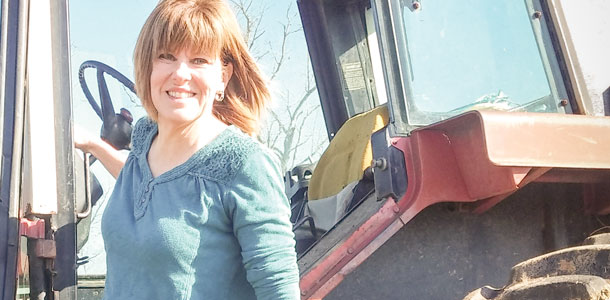Above all this noise, chaos and rancor, two words consistently rise to the top – forage and family. For us, they’re more than buzzwords.
My husband, Scott, and I own and operate Pannill’s Gate Farm, a cow-calf operation in Orange, Virginia, and we’re members of the Virginia Forage and Grassland Council.
We’re a true husband-and-wife farming operation. There’s nothing better; there’s nothing worse. It’s forage, family and fireworks.
Like every other piece of ground in America, Orange, Virginia is historically important and environmentally sensitive. We’re close to Washington D.C. in the Chesapeake Bay watershed, so we’re under the regulatory microscope.
We have a lot of residential encroachment where farms were busted up, and big land tracts are hard to come by.
Although Scott and I were both involved in agriculture throughout high school years, guidance counselors of our day were saying agriculture was out and electrical engineering was in.
So we both became electrical engineers working for defense contractors. We both ended up in Virginia, got married and ended up buying a few acres because we were just going to run a few cows. We’re now a glorified cow-calf operation. Forage is the only way we make it work.
In the beginning, we were so dumb we hardly even knew what cow-calf meant – but Scott had worked on a dairy, and my family had a milk cow, so how hard could it be?
We started with three pairs and eventually added Holstein bull calves. We’re engineers – so we’re thinking, we’re planning. We’d put some land in CREP and our fencing was pretty good, so we bought 30 bred second-calf heifers.
It wasn’t a total catastrophe, but it was pretty close. We learned the hard way about winter feed costs, feed efficiency, fescue toxicity, black cows in the sun – all while we were going into and mostly out of the hay business. Clearly, we needed to re-think what we were doing.
Keeping cattle healthy is a priority. Every calf gets weighed and tagged, usually within the first few hours of being born. We band and vaccinate them when we preg check.
We quarantine animals moving in, even our own cows coming from other farms and our show animals. We do not have respiratory problems but have had to double-down on pinkeye.
We call the vet, find out what they suggest and go with that – because what works one year may not work the next.
We’re in the fescue belt. We manage it with winter annuals, summer annuals, frost-seeded clovers and Max Q (tall fescue perennial). And I’m out there just about every day moving cows.
So what makes it work? First, we reassess our marketing every year, based on forage availability, cattle prices, number of open cows, availability of labor.
Our steer calves are retained for our direct-market grass-fed beef program. Heifers go back into the herd, but if they don’t look like they’ll work out for us as cows, they’re sold private treaty.
Even our cull cows are sold private treaty – we cull early since the sale barns are penalizing lame or old cows pretty hard.
In July of 2013, we got a phone call out of the blue: were we interested in leasing a 400-acre farm if it was kept in pasture? It had water and decent enough fencing.
For us, it was the chance of a lifetime. We were operating then on about 200 acres, complaining how grain prices have driven up the prices on rental land, land being pulled out of CREP for row crops, not having cash, not having enough cows.
Even thinking about going from 200 acres to 600 acres is terrifying, and we almost said “no” – but we didn’t.
It took exactly two phone calls to get into the contract grazing business. A friend had 30 Simmental x Angus cows and we calved them out this past January.
They’re good cows, not the best fit for our own operation, but they raise tremendous calves and we’re doing this on shares. And it worked well enough for everyone that we’re doing it again this year.
Calving season is so much fun that we have three of them. It’s a case of “does calving influence marketing” or “does marketing influence calving?”
You’ll hear people talk about calving with nature, in April and May, but that means breeding back in July and August, and that’s a lot to ask of a cow.
It seemed like we were culling a lot of good cows and then replacing them with ones that weren’t any better. We now let some of our cows slide to fall.
So in January, our contract cows are calving; in April, our spring herd calves – and we just bought a fall-calving group.
Our contract cows are being sold by the truckload, so we want a tight, early group. We’re direct marketing most of our steers, so we’re actually flattening out our finishing schedule on them – we don’t want them all finishing at the same time.
I wouldn’t suggest this for most producers, but if you’re direct marketing, do you really need that tight calving window?
We don’t own any hay equipment, but we make a lot of hay. We’ve combined resources with our neighbors – we supply critical labor, they supply equipment.
We do fuel runs, parts runs and move equipment – and the schedule can get ugly. But everyone’s hay gets put up. Part of the reason we can do this is because of wet hay – we wrap a lot of hay and grow warm-season annuals, moving nutrients around.
We wore out our 10-foot no-till drill with custom planting. While everyone around us has big monster planters, we were the only ones who could get through a 12-foot gate.
During planting season, that thing runs constantly. Other than that, we manage with less equipment than most producers and only own a pick-up, a small stock trailer, our big Kubota tractor, a 15-inch bat-wing bush-hog and a lawnmower.
Sounds rosy, doesn’t it? Yeah, not quite. Animal control has me on speed dial. Fortunately, at least lately, it’s because I know who owns what animals – I’m a resource – but that hasn’t always been the case.
They used to get welfare calls on our cows, especially in the winter, because we weren’t feeding hay. But they understand grazing and they’re a big part of our education program.
These welfare calls were usually from a neighbor, somebody we don’t deal with directly, and the folks at animal control can really help us out.
We’ve been fortunate enough to find landowners who understand fence and water are improvements and increase property values.
It’s harder to sell them on working facilities. Haven’t pulled that one off yet, but we can make management adjustments and put cows that need less handling in the pastures where working facilities are weaker.
Besides our landowners, there are so many people who make this possible – NRCS and FSA help us navigate the government programs, and extension staff and researchers do some amazing work, and we depend on Charlie and Tim, our agronomists. There’s a lot of knowledge and talent a phone call away.
For Scott and me, “forage and family” is not a trend or marketing strategy. It’s not a survival tactic. It’s who we are and what we do.
Beyond this free-for-all that’s going on around us – PETA, the EPA, mommy-bloggers – forage growers are the voices of practicality and reason. Our time has come. FG
This presentation was given at the American Forage & Grassland Council competition in the 2014 Forage Spokesperson Competition. Johnson was sponsored by the Virginia Forage & Grassland Council.










